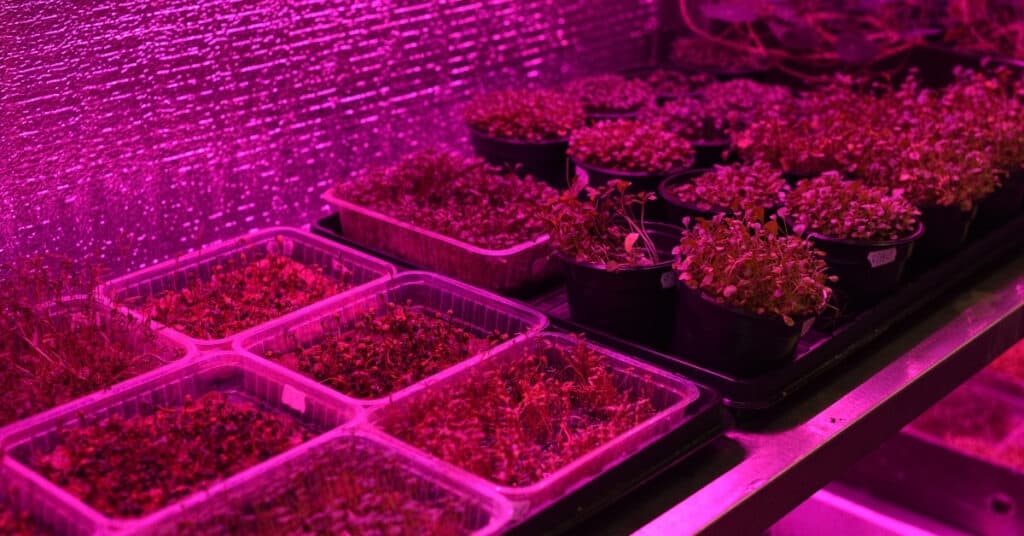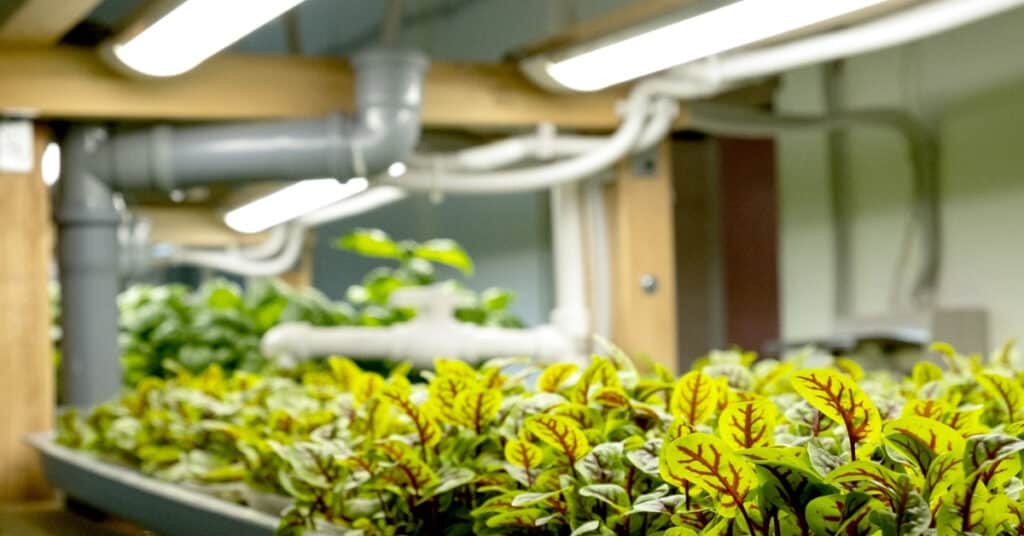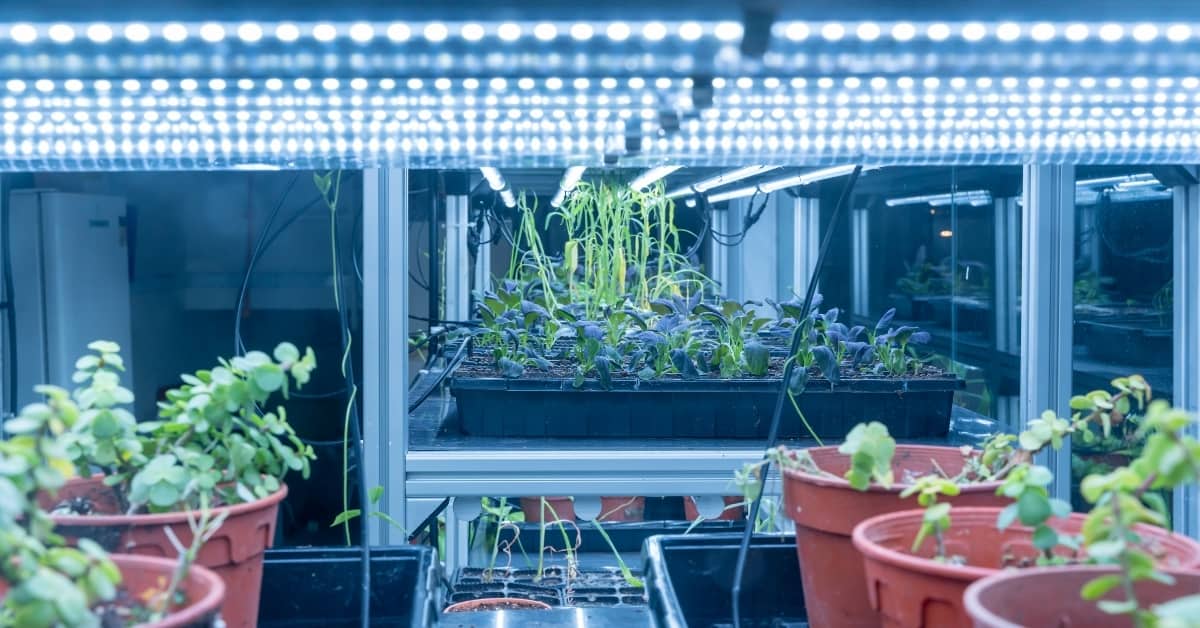Choosing the best grow lights for microgreens needs more than your perception of how bright the light is. Let’s know, how!
Your plants’ need from the grow light isn’t always visible to the naked eye and knowing what to look for is the best way to choose lights that fit your needs.
When selecting grow lights for microgreens, check out the spectrum they provide, programmability, durability, consumption, and heat output, among other qualities. It is also necessary to consider the nature of your purpose and the setup you’re thinking of creating.
With an idea of how your microgreen garden should be and some knowledge on what to look for in grow lights, you’ll likely find the best product to satisfy your needs. In this article, you’ll learn the things to keep in mind while choosing to grow lights. You’ll explore some lighting options, check out some of the best products, and more.
What To Consider When Choosing Grow Lights For Microgreens
When picking the best grow lights for microgreens, you need to scrutinize the grow light’s qualities, the light it produces, and overall setup. Check out the factors to consider outlined in detail in this section.
Color/Spectrum of the Light
Light is made up of many colors specific to particular wavelengths. Scientists discovered that certain wavelengths favor some stages of plant growth more than others. However, they also realized that blue and red light are essential light colors for healthy plants’ growth.
These colors fall under the PAR or Photosynthetically Active Radiation range. It’s the spectral range between 400 and 700 nanometers, which plants use for photosynthesis. Each light spectrum is useful for certain plant stages like flowering and the development of flavors in the plant.
Here’s a table showing the effects of different light spectrums on microgreens:
| Wavelength in nanometers (nm) | Effect on microgreen growth |
|---|---|
| 400-500(Blue light) | -Facilitates overall enhanced growth and plant quality -Increases chlorophyll accumulation and opening of stomata -Enhances anthocyanins content -Improved flavor, aroma, and taste |
| 500-600(Greenlight) | -Promotes photosynthetic processes |
| 600-700(Red light) | -Stimulates photosynthesis and increases plant biomass -Increases phenols, ascorbic acid, and flavanols -Enhances macro and micronutrient |
Using full spectrum grow lights is the best option for high-quality microgreens. This way, each light spectrum can influence different aspects of the microgreen growth and result in excellent quality.
How Different Colors of Light Affect Microgreens
You can use the following grow lights to treat microgreens and facilitate exceptional results:
- Red light: If you want to stretch your microgreens vertically and increase the internodal spacing, this is the best light option you can use. Moreover, you can gain more flavor and nutritional content if you incorporate standard green and blue light doses.
- Greenlight: Although adding green light to your microgreens may not show visible changes when used with other spectrums, they can grow really fast.
- Blue light: If you want sturdy, flavorful microgreens with increased color and scent, add blue light. You might notice a purple hue developing due to rising levels of anthocyanin.

If your focus is on the tastiest, flavorful, and generally high-quality microgreens, you should get full spectrum grow lights.
Some manufacturers call their full-spectrum lights “white” lights, but sometimes it’s just a mixture of two or more colors. Otherwise, red, blue, or green lights will grow your microgreens just fine.
You can do light treatments throughout the microgreens’ growth cycle or focus on the time near harvesting. As you make trials and notice the differences, you can adjust your microgreens growing routine and produce the tastiest microgreens for your family or customers.
(Sources: US National Library of Medicine, Lumigrow, Urban Vine)
Programmable Qualities of a Grow Light
Depending on your automation needs, you need to check out the programmability of the particular grow light you’ll be using. This is the adjustability of different lighting properties of the grow light.
On And Off Timer
You need to know how hands-on you want to be with your microgreens garden. If you can turn the lights on and off manually every day and maintain proper timelines for your microgreens’ healthy growth, you won’t need a timer.
However, if you want to automate your microgreens garden, functions like timers will be vital because you don’t want to forget to adjust the correct light hours for your microgreens and ruin them.
Spectrum Adjusting
If you only need grow lights to grow microgreens for your family, you might only need a particular light spectrum like blue light. However, if you’re a business grower, you’ll need to modify the produced spectrum from time to time, especially to do light treatments.
Different color temperatures produce mixed results in the microgreens. So, a commercial grower might adjust the lighting colors to enhance the flavors, nutritional content, and microgreens’ look to improve desirability.
In such a case, lighting that can be adjusted to produce different spectrums is vital for light treatments. When the grower needs to boost beta carotene and boost the flavors, all they have to do is change or add some color to the already existing photosynthesis facilitator.
How Much Power Your Grow Lights Will Consume
A good grow light is energy efficient. Therefore, you need to check the wattage of a particular grow light used to determine its fit for you. Otherwise, you might buy a cheap grow light but realize it’s using outrageous amounts of power to illuminate your microgreens.
If you are using a 1000W grow light to illuminate your microgreens for 10 hours a day, it means you’re using 10Kwh per day. If 1Kwh costs 10 cents, then you’ll be spending $1 a day to light your microgreens.
You can calculate the amount of electricity different grow lights will use per day and compare them according to their spectrum emission abilities to find one that suits you. However, avoid cheap grow lights that’ll cost you a ton of money on electricity. They’re more expensive in the long run than you might realize.
The Durability of Your Grow Light
You need to buy grow lights with high-quality materials and build. Commonly, US products are recommended, but if you can source a grow light with a reputation from anywhere worldwide, do so.
Some things that show grow light longevity include:
- Material structure
- Technology
- Company reputation
- Warranty
Check Customer Reviews
In general, you’ll want to do your homework before investing in grow lights. Here are a few best-sellers that have great reviews for many of the reasons above.
- Barinna Full-Spectrum LED Grow Light – easy to install, super-bright, energy-efficient
- Hytekgro LED Grow Light, Red Blue White – great value, easy to use, lightweight
- Spider Farmer LED Dimmable Grow Light – high-quality, dimmable, well-built
We’ll cover more great grow light suggestions in just a bit.
Consider that Grow Lights Have Different Heat Outputs
Grow lights come with different heat outputs according to their build. Some emit heat enough to scorch your microgreens while others are safe to use even when placed near the plants. Moreover, if a grow light has a higher heat output, electricity consumption is generally higher.
Accessories Needed to Set Up Grow Lights for Microgreens
Some grow lights setups require overhead hanging, others need setting up the ballast, and those that come without overheating safety solutions may need a separate fan to cool them. Therefore, you need to know precisely what you’re buying and what you might need to achieve the full setup in your growing space.
The following are grow light setup requirements to think of:
- Cooling: If you don’t like the fans’ buzzing noise in your growing space, you should buy a grow light with built-in cooling technologies.
- Mounting: Picture what your growing area is like and choose the appropriate grow light from ballast-reinforced to lampstand options.
- Power cord
- Racks: You’ll need these to mount trays to use the light efficiently.
- Tents
Some grow lights come in complete kits for plug and play convenience. However, others need some support and knowing that in advance will help you choose the right grow lights for your microgreens.
Microgreen Lighting Depends on How Much You Grow
If you’re growing microgreens for home use, you might not need to invest a lot in your lights. Especially if your microgreens are for feeding a small family, you can opt to place them beside a sunny window or at your balcony, and the sunlight will be enough to produce sufficient micro veggies.
Moreover, if you won’t be expanding your microgreens garden for home use, affordable compact lights may work just fine for your gardening. You can also use the LED lights you use to light up your space to produce micro veggies.
However, commercial growers need to think about the best grow lights that’ll produce the highest quality microgreens for their customers. As long as the return on investment is viable, they can purchase the best and most expensive lights.
Number of Trays
Whether you’re a subsistence or commercial grower, the number of trays you plan to use influences the lighting you’ll use as well. If you plan to start with numerous trays, you might have to build a multistory rack with panel lights.
If you’re looking to expand the number of trays in the future, you should get lights you can expand instead of single lampstands, which can only illuminate a small area. For instance, grow bulbs are less expandable than panel lights, so the past investment might become inefficient if expanding in the future.
Growing Location
Maybe you have a sunroom, greenhouse, or you want to grow your microgreens in the closet. You have to think about where you want to grow your microgreens to determine the best lighting for that location.
If your microgreens trays can be fitted around your living or working space, then using your space lights to grow them could work. If you have a sunny area you can use, then you might not need as many grow lights or any at all.
Budget
Grow lights come at different prices according to their durability, light spectrum, and build material, among other factors. Therefore, determining what you’re willing to spend on grow lights might be the most essential factor to consider.
(Sources: Bootstrapfarmer, Technology.org)
Lighting Options For Microgreens Growing
You have five major lighting options to choose from. As you check out the details for each of them, you’ll likely realize what you need to get for your microgreens garden.

LED Lights
Light Emitting Diodes (LED) lights are one of the best lights to use for growing microgreens. They’re getting more common and feature in subsistence as well as commercial gardens. They are the future for indoor gardening.
These lights are incredibly energy efficient, using at least 75 percent less energy than incandescent lights. Moreover, LED lights can last up to 50,000 hours, or 11 years on 12-hour cycles. They rarely burn out but instead depreciate in their luminosity.
The following are advantages of LED lighting:
- They’re lightweight and, therefore, easy to setup
- They don’t need extensive wiring to connect
- They produce minimal heat and are less damaging
- They’re energy-efficient
- They are tough to break
- They’re environmentally friendly
Although they used to be extremely expensive due to their quality, LED lights are getting cheaper as the market demand increases.
If you wish to do non-professional microgreen gardening, you can choose the most affordable LED lights according to your budget. Even standard shop lights might work for a few trays.
Moreover, you should know that the light temperature, which also reveals the color, is measured in Kelvins abbreviated as K. The higher the number, the higher the temperature and the nearer its properties to the sun.
If you want full-spectrum light, you’re better off choosing a 6000K LED bulb than that of 3000K. But you’ll have two options to choose from: LED shop lights and LED grow lights.
(Source: Energy.gov)
LED Shop Lights
These are simple lights used in shops, garages, and workshops to illuminate a specific area effectively. Their cost-effective lighting realized in the long term, excellent illumination, and other advantages mentioned above make them highly sought after to replace fluorescent lights.
Even better, you can grow your microgreens with LED shop lights. They provide a spectrum necessary for microgreen growth and are inexpensive alternatives to LED grow lights. You can also start growing with the LED lights you already have and get others as you expand your garden.
LED Grow Lights
These come specially prepared for growing indoor plants. They feature timers, attachment technology, and particular light spectrums to accommodate specific growing needs. If you don’t have LED shop lights and aren’t thinking of getting any in the future, you can get grow lights, so you benefit from the different functionalities that come with them.
Moreover, LED grow lights are built to last even with the harsh conditions present in a growing space like water and dust. They have tough exteriors to take minimal impacts and, therefore, last more than a decade.
Fluorescent Lights
You can use the standard fluorescent lights you find in bright shops to grow microgreens. While more people are switching to LED lights, some growers still get excellent yields using these lights. However, they use more power to operate and are less environmentally friendly due to the mercury in the tubes.
You can use existing fluorescent flights to grow your microgreens if you only wish to do that for subsistence. You can replace them in the future as their quality depreciates or when you want to expand your garden.
Sunlight
This is the cheapest and most broad-spectrum you can get. If you’re a subsistence grower, a sunroom or a window sill is all you need to soak this light in your microgreens. For the business grower, you might need a greenhouse or similar setup to facilitate natural microgreen growing.
You might not need timers or any light set up accessories. However, keep in mind that you won’t be able to rely on sunlight all year round, the heat might be too harsh for microgreens, and you might have to use vast tracts of land since vertical setups would be limited.
However, if you’re a beginner grower, one of the best ways to start is using natural light. As you get used to the craft, you can switch to artificial lights and keep planting microgreens without depending on weather and season changes.
Pros to Using Grow Lights for Microgreens
Artificial lighting for growing microgreens indoors is genuinely beneficial. That’s why you’ll find them being used everywhere. The following are the advantages of grow lights:
They Facilitate Growing Of Microgreens Anywhere, Anytime
Whether you live in the tropics or Iceland, growing microgreens is possible with grow lights. This technology doesn’t depend on external conditions but enables similar light to that of sunlight. You can do microgreens gardening all year round and produce fresh vegetables at the comfort of your home.
They Enable Usage Of Extra, Unused Space
Many people rarely use their basements, attics, and other spaces in their houses or offices. But with grow lights, you can use any extra space for vegetable production. Even better, these grow lights facilitate the usage of vertical gardens in racks so you can use a small basement to feed your whole family throughout the year.
They Are Easy To Control
As opposed to sunlight, which might scorch microgreens, grow lights can be controlled to create an optimal environment at all times. You can set the best timeline for the lights to be on, the spectrum needed for high-quality produce, and even the intensity you need them to illuminate with.
They Facilitate Light Treatments
Providing the best produce all the time in sunlight or standard lights is unrealistic. However, with grow lights, you can boost flavors, aromas, and even visual elements of the microgreens by changing light spectrums. This enables you to produce the best quality you want after experimenting with a few light treatments.
Cons of Using Grow Lights for Microgreens
But not all is perfect with grow lights. Here are some disadvantages of using artificial lighting technology to grow microgreens:
They Are Costly
While growing microgreens with sunlight is mostly a matter of choosing to start, you have to think about the cost with grow lights. They come at a price, and generally, the higher the price, the better the product. Therefore, for those with nothing to start at all, growing microgreens with artificial light may be impossible.
But the costly nature of grow lights doesn’t stop at purchase. These lights use electricity to work and therefore, they’ll still cost you as long as you’re gardening. Especially if you go for the cheapest options, your energy bill will be high in the long run.
They Are Dependent On Electricity
Relying on the power to operate is a disadvantage on its own. If electricity becomes unavailable in your area, your microgreens might die or not show up in good quality. Even worse, if your area usually has an unreliable electricity supply, you might have to purchase back up power source or be unable to grow microgreens indoors at all.
You Might Need More Than One Type
To facilitate optimal growth and quality of your microgreens, you might need to use more than one type of grow light. Depending on your garden setup, you might require more than one light spectrum to fulfill your produce needs.
Best Lights For Microgreens
Now that you know what to look for in microgreens lights, you need to check the best in the market so you may determine what suits your needs. Here’s a list of the best microgreens grow lights:
Active Grow LED Grow Light Fixture
The LED Grow Light Fixture from Active Grow generates light in full spectrum thanks to its latest phosphor chip technology. It boasts its long life of 40,000 hours, and the company guarantees durability with a 3-year warranty. It also sparks confidence in many customers since it’s made in the USA.
This grow light is specially designed for horticulture use like growing microgreens and other vegetative plants. It comes complete with a power cord, daisy chain, and a connector, so you don’t need additional accessories to make a clean setup.
Juhefa Professional Full Spectrum Panel
This Full Spectrum Panel works for microgreens, seedlings, succulents, and even clones. Armed with 75 high-power LED chips, this panel can produce the complete spectrum for optimal microgreen growth. It boldly boasts its high energy efficiency claiming you’ll only use $3 per month while leaving it on for 12 hours.
With a 12-month warranty and a 30-day money-back guarantee, you can get this for small scale microgreens growing. Its ABS material body for impact, heat, chemical, and scratch resistance, can promise more than a year of usage.
VOGEK LED Growing Light
The VOGEK LED Growing Light is equipped with 144 light beads responsible for full-spectrum spectrum light. It’s highly programmable thanks to its automatic on and off timer, which you can tailor according to the light hours your microgreens need. Even better, it has three switch modes with brightness from 10 percent to 100 percent.
Offering light from 300nm to 800nm, this lamp can provide all the spectrums needed high-quality microgreens. By using its strong clamp to mount, you only need to plug and start using this 72W grow light. With almost five stars left by buyers nearing 3,000, you can trust this grow light stacks up to excellent standards.
T5 Grow Lamp
If you want a more professional setup of your microgreens garden, the T5 Grow Lamp from Roleadro Store may be what you need. It offers a rich, full-spectrum from 3000K to 6000K. With it’s automatic on plus off timer and three timing modes corresponding to a specific spectrum, you can set full cycles and carry out light treatments conveniently.
Using the four brightness levels provided, you can adjust them between 25 and 100 percent to meet your microgreens demand at each stage. You can install one or many of these LED lights to power your garden using the professional manual included with the complete installing kit.
Your Microgreens Grow Lights Questions Answered
If you’re thinking of buying grow lights for your microgreens, you likely have more questions you need answers for. The following are the most common questions about microgreens growing lights — with solutions.
Can I Use Incandescent Lights To Grow Microgreens?
You can use incandescent light to grow microgreens, but it would be a waste of resources.
First, incandescent lights use heat to produce light, therefore resulting in almost 90 percent heat to provide light. This is disastrous for microgreens since you can easily scorch them while trying to help them absorb light.
Moreover, they are highly energy inefficient and are about to be phased out of the market. They also aren’t a reliable source of the full spectrum needed to grow healthy microgreens. It’s better to avoid incandescent lights and buy fluorescent or LED shop lights if you need a low-cost option.
(Source: Howstuffworks)
How Far Should Grow Lights be From Microgreens?
This mainly depends on the light’s heat dissipation since you might scorch your microgreens if you place them too close to certain grow lights. However, with most minimal heat output lights, you can place your microgreens 6 to 12 inches away from the light.
You should note that if the greens are too far from the light source, they might get too stretchy and weak. Therefore, you can check your manufacturer recommendations and experiment with different placements to discover your microgreens’ best distance with a particular grow light.
How Many Light Hours Do The Microgreens Need?
You need at least 6 hours of light to grow microgreens. If you’re growing with sunlight, you have to observe the direction of the solar rays and the shade variations to determine the optimal hours to expose your microgreens too.
For artificial lights, there’s no cookie-cutter approach to this. You’ll find some growers exposing their microgreens to light 24/7 to speed their growth. Others expose their plants to 18 hours of grow light per day while they let the plants rest for the remaining 6 hours. But on average, microgreens need 12 hours of light for optimal growth.
Conclusion
Now that you know what to look for in grow lights, the best lighting options you have, and the advantages of each, you likely have an idea of what to choose.
If you had doubts about indoor gardening with artificial lighting, you’ve found the pros and cons to help you come up with a confident decision. You can choose the above-recommended products if they fit your needs or go for the best at a nearby store with the insights you have.

